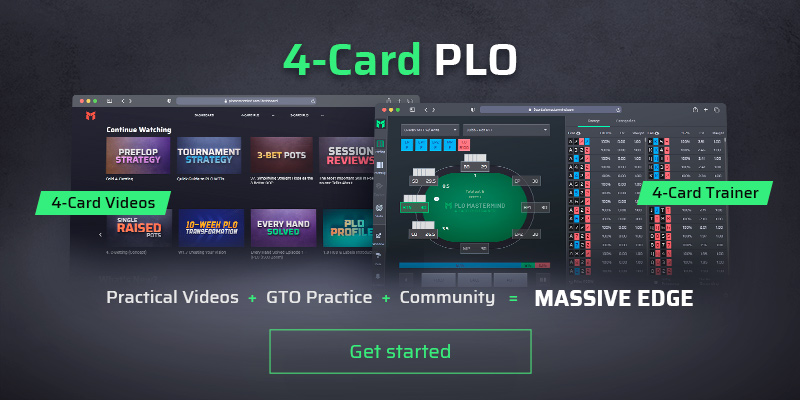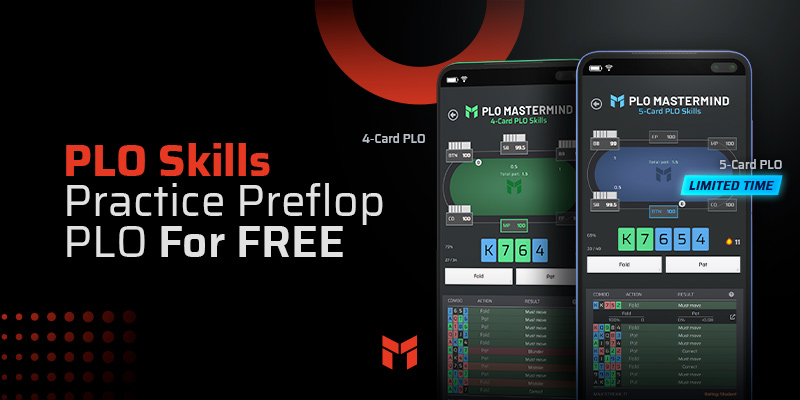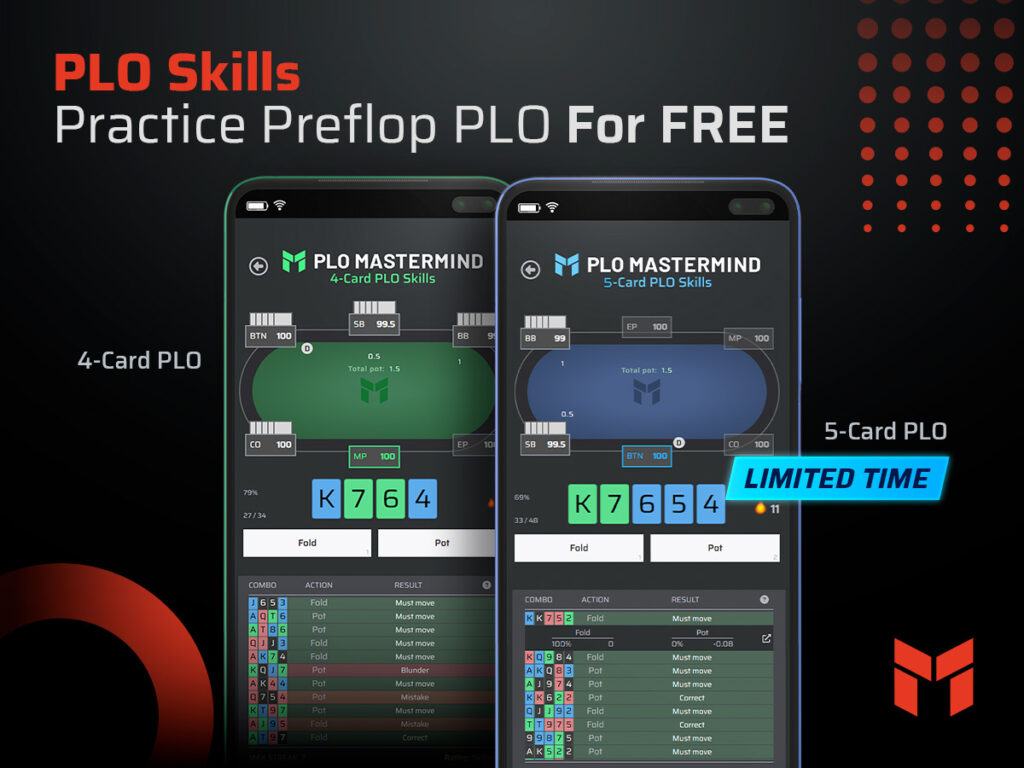What should you do if you get re-raised in PLO?
Understanding this aspect of the game is pivotal, as it sets the stage for postflop play. Through this guide, we will improve your PLO strategy, focusing on the essential tactics for facing 3-bets, leveraging insights from advanced poker training, game theory optimization (GTO) principles, and specific player type exploits.
Whether you’re looking to learn poker basics or enhance your expertise in Omaha poker, these tips will help refine your approach, offering a poker training blueprint to thrive in today’s competitive online poker arenas.
1. The more rake you pay, the more you should fold
When facing a 3-bet, rake plays a critical role in your decision-making process. Higher rake directly eats into the expected value (EV) of your hands, making it tougher to be profitable postflop. Therefore, it’s essential to adapt your strategy based on the rake’s impact.
In high-stakes, low-rake environments, you can afford to be more aggressive against 3-bets. Conversely, in low-stakes games where the rake is higher, folding becomes increasingly advantageous.
For example, the fold percentage in the CO in response to a 3-bet from the BTN jumps from 21% in a low rake setting to 47% when the rake is high. This adjustment is vital for maintaining a healthy win rate, illustrating the importance of considering rake in your preflop strategy.
2. Always 4-bet AA with 100BB or less
In Pot Limit Omaha, 4-betting AA when 100 big blinds deep or less is a strategic move aimed at maximizing your equity advantage. The goal is to lower the stack-to-pot ratio (SPR), setting up a scenario where you can comfortably go all-in on most flops, thereby capitalizing on the equity established preflop.
However, an exception arises when you’re facing a 3-bet from an opponent with a notably tight range and you’re in position. In such cases, especially in medium rake games, selectively calling with your most marginal Aces can be advantageous. You don’t push much of an equity edge against a tight range but can leverage the positional advantage postflop by just calling, benefiting from a higher SPR.
3. Never fold double-suited hands
Double suited hands are often key to successful strategies, offering the potential to flop strongly and continue profitably. Therefore, they should almost never be folded preflop due to their high postflop playability.
However, it’s important to consider the context of high rake games, where the rake’s impact on your potential profit means some discretion is needed. In such environments, the least connected double suited hands may warrant folding. This nuanced approach to handling double suited hands in different rake conditions underscores the strategic depth of PLO.
4. Think ahead when you raise first in
Before deciding to raise, a crucial step is to anticipate potential 3-bets and plan accordingly. This proactive approach serves not only as a test of your poker knowledge, allowing you to gauge your readiness for various outcomes, but also enhances your game through strategic foresight.
Recording and reviewing the hands you play, especially those where you might face a 3-bet, contributes significantly to your understanding and skill development in PLO. Such analysis can reveal insights and patterns not immediately evident during gameplay.
Moreover, understanding your opponents’ tendencies, such as a propensity to over 3-bet, enables you to adjust your strategy in real time. Tightening up your raising range to exclude hands that falter against a 3-bet optimizes your play, aligning it closer with Game Theory Optimal (GTO) strategies while still allowing for exploitative adjustments.
5. At 50BB you fold more, at 200BB you fold less
Your approach to facing 3-bets should dynamically change with your stack depth. With deeper stacks, your tendency to fold decreases. This shift is due to the increased implied odds and the enhanced ability to maneuver postflop, crucial aspects when you’re generally at a range disadvantage against an opponent’s 3-bet range.
Deep stack play amplifies the value of implied odds, allowing for a broader range of hands to be played profitably in response to a 3-bet.
For example, when analyzing situations from the cutoff (CO) position facing a 3-bet from the button (BTN), the fold frequency significantly varies with stack size. At a shallow stack depth of 50BB, you might fold 40% of the time, but this percentage drops to 22% at a 200BB depth. Holding position with 200BB stacks, folding becomes a rarity, highlighting the strategic flexibility provided by deeper stacks in PLO.
6. Hand classes that don’t flop very smoothly fold the most
Utilizing PLO Trainer simplifies the process of identifying which hands to fold when faced with a 3-bet. By filtering for specific hand types, such as triple, rainbow, and mono-suited hands when you’re out of position, you quickly learn these combinations constitute a significant part of the hands you should fold against a 3-bet.
Additionally, single suited, unpaired A-high hands often find themselves in the fold category. These hands, typically dominated by the aggressor’s 3-bet range, struggle to realize equity smoothly postflop. This strategic simplification, facilitated by poker training tools, underscores the importance of understanding hand selection and positional dynamics in PLO.
7. You fold a lot more when out of position
Playing out of position presents a significant challenge in realizing your hand’s equity and successfully reaching showdown. This difficulty requires a strategy where folding more often becomes essential to combat the range disadvantage inherent in such scenarios.
Conversely, when you have the advantage of position, the need to 4-bet decreases. Holding position allows you to maintain a higher stack-to-pot ratio (SPR), a critical factor in postflop play, enabling more strategic flexibility and potential profitability.
The frequency of 4-betting changes based on position; for instance, early position (EP) players might 4-bet against a button (BTN) raise 18% of the time, but this frequency drops to 12% when facing a big blind (BB) raise. These percentages highlight the strategic adjustments required in PLO based on your positional dynamics and the importance of SPR management.
8. Proper adjustments against a maniac
When facing a highly aggressive, or “maniac,” opponent, adapting your strategy is crucial for exploiting their playstyle effectively. Here are three key adjustments to consider:
- Narrow Your Opening Range
With aggressive players looking to 3-bet frequently, your fold equity diminishes preflop. Tightening your raise first in (RFI) helps mitigate this by ensuring you enter pots with stronger hands, better suited to withstand increased aggression. - Hold Your Ground Against 3-Bets
Once you’ve refined your opening range, folding against a 3-bet becomes less desirable. Given that your opponent’s 3-bet range is likely to be broad, your stronger RFI range can justify calls more often, allowing you to contest pots even out of position. - Expand Your 4-Bet Range for Value
Knowing that your opponent’s 3-betting range includes weaker hands, it’s advantageous to 4-bet more liberally with strong hands beyond AA. At the same time, dial back on 4-bet bluffs since your opponent is less likely to fold, making value plays more profitable.
These strategies leverage the predictability of a maniac’s aggression, turning their tactics to your advantage by ensuring you engage more profitably in pots.
9. 4-bet bluffs want to unblock your opponents folding range
When devising a 4-bet bluffing strategy, it’s pivotal to select hands that do not inhibit your opponent’s likelihood of folding, while still retaining equity in case of a 5-bet shove. A key heuristic in this context is to favor hands without a King. This choice stems from the desire not to block potential 3-bet / folding hands in your opponent’s range, maximizing the chance they fold to your bluff.
Simultaneously, these selected hands should maintain enough equity to give you fighting chances should the hand go to a 5-bet scenario, acknowledging the infrequency with which you’ll be folding to such aggression.
Conclusion
Navigating 3-bet scenarios effectively in Pot Limit Omaha is crucial for any aspiring or seasoned player aiming to excel in the fast-paced world of online poker. This guide has distilled essential strategies, leveraging advanced poker training and game theory optimization to refine your approach to these pivotal moments.
PLO demands continuous learning and adaptation. Applying these strategies will not only deepen your game understanding but also improve your performance. As you integrate these insights into your play, you’ll find yourself better equipped to tackle the challenges of PLO, turning complex situations into opportunities for profit and growth.
Good luck at the tables!




